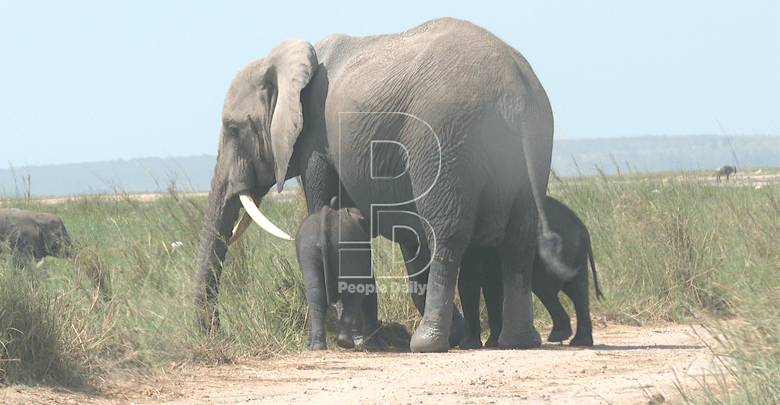Concerns rise over dwindling Amboseli ecosystem

Bernard Gitau @benagitau
Crowned by Mount Kilimanjaro, Africa’s highest peak, the Amboseli National Parks is one of Kenya’s most iconic and popular parks.
Mt Kilimanjaro overlooks the park to the south, and buffalo, zebra, gazelle, wildebeest and the majestic African elephants migrate throughout the landscape every year in search of seasonal pastures.
The park has over 1,600 elephants and last year reported the birth of more than 170 calves and counting.
What’s more, two sets of twins were born in 2020, anchoring its status as the top-ranked tourist destination in Africa.
Famed for its abundant wildlife, Amboseli is estimated to bring in about Sh3 billion a year from park fees and related tourist activities.
Though a critical ecosystem, Amboseli, also known as Home of the African Elephant is facing extinction with wildlife conservationists asking for quick government intervention.
Kenneth Ole Nashu, immediate former Senior Warden Amboseli National Park, speaking to the People Daily, said systemic and well-choreographed wildlife corridor encroachment is spelling doom for the park and the entire ecosystem.
“Amboseli is too small to support viable populations of certain species.
Wildlife is dependent on community lands outside the Park,” said Ole Nashu, adding that six community group ranches surround the park, including Kimana Group Ranch.
Unfortunately, over the past two decades, Kimana has sub-divided its land into 60-acre lots.
“With wildlife corridors decreasing daily, the fear of losing Amboseli National park is inevitable in the next 10 years.
Confining the wildlife to the park will not be sustainable. If we will not lose it, it will turn into a zoo,” warned Ole Nashu.
Samuel Kaangi, Amboseli Land Owners Conservancies Association (Aloca) chair, said poaching and human wildlife conflict are challenges facing the ecosystem, but conversion of corridors to farmland presents a bigger problem.
“The sub-division has resulted in land sales that have left pastoralists landless, as well as mixed land use not-compatible with conservation, including farming, development, settlement and fencing,” he said.
Kaangi said this has resulted in a significant challenge to wildlife movement and traditional pastoralism.
Continued clearing of 180 acres of wildlife habitat in preparation for avocado farming, has raised opposition from local and international conservationists.
As it is, there is already another vegetable farm close by permitted two years ago for agricultural development on 120 acres. It has since expanded to 540 acres.
Sadara Kolingo Kimana, says lands under the farming project were elephant’s maternity and watering points.
“We used to see over 10 elephants with their young ones in one of the shambas, but at the moment, we can’t because the area has been fenced off and turned into a vegetable farm,” said Kolingo.
Kimae Ole Mapena, Ole Polos Conservancy chair, adds that continuous use of pesticides in farms is killing bees and other insects.
Wildlife Direct has also opposed farming on corridors, saying such projects threaten buffer zone and wildlife migratory corridor, therefore, threatening the integrity of the park.
“The land within the corridor has been zoned for pastoralism and wildlife and not farming according to the adopted and ratified Amboseli Ecosystem Management Plan,” said Wildlife Direct CEO Paula Kahumbu.
Following outcry from the local community and conservation groups, National Environment Management Authority announced its intention to revoke the license for the avocado farm.
The case is being appealed in the National Environment Tribunal of Kenya and is now in court.
Conservationists fear that if the agricultural company wins, it will be an open invitation for developers to continue with the rapid destruction of Amboseli’s unique environment—one of only five Unesco Biosphere Reserves in Kenya.
Key corridor
Daniel Ole Sambu an officer at Big Life indicates Kimana is a key migratory corridor.
“It is the central part of a crucial corridor that links Amboseli National Park with the Chyulu Hills and Tsavo protected areas, providing animals with a route through the narrowest part of the space between two settled areas,” he said.
Sambu says the dispersal areas south of the park and the Kitenden wildlife corridor linking Amboseli to Kilimanjaro forest is threatened by increased settlement.
Similarly, settlement along the Loitokitok Pipeline and farming on lower slopes of Chyulu hills threatens to sever migrations between Amboseli and Tsavo West through Mbirikani and Kuku group ranches, as well as access to the hills.
“In addition, irrigated farms and fences around Namelok and Kimana and settlement and sedentarisation elsewhere in the ecosystem threaten continued wildlife migrations and, especially elephant movements to and from Amboseli,” he said.
Due to escalating human developments, Sambu said, elephant movement has been confined to three major corridors: Mbirikani, Isinet and Empiron corridors and the linking Kimana Sanctuary.
Kaangi said after the Kimana Group ranch was sub-divided and given to individuals, the corridor was threatened because members sold their land, which later turned into agricultural areas.
“Due to its significance as a wildlife corridor, over 400 landowners out of 800 original owners of Kimana Group ranch formed six conservancies to facilitate wildlife migration,” he says
Though conservancies have relieved the diminishing wildlife corridor, farming is still being practiced in some of the lands adjacent to the conservancies.
“Landowners who did not convert their land into conservancies are selling to investors who are not considering land use practice in the area and are getting into farming,” adds Kaangi.
Government bureaucracy
In an effort to protect wildlife habitat and provide direct financial benefit to landowners, Sambu says Big Life has established a Payment for Ecosystem Service (PES) programme, which entails leasing of land for biodiversity conservation from 400 Maasai landowners.
The leases are legally binding and outline land use restrictions that must be met in order for payment to be received.
“Some of restrictions include no farming, fencing, blocking wildlife movement, commercial resource extraction and development,” he said.
They are also working with the private sector to create inclusive ecotourism opportunities and generate additional sources of income for landowners.
Ole Nashu blames government bureaucracy saying land could have been leased or bought from the Maa Community by the Park to salvage the corridors.
Last year, Tourism Cabinet Secretary Najib Balala launched the Amboseli Ecosystem Management Plan alongside the Amboseli National Park Management Plan at a ceremony held at the park’s Kimana gate.
The Amboseli Ecosystem Management Plan outlaws activities within or along migratory routes to facilitate and maintain wildlife habitat connectivity.
The 10-year integrated management plans have been necessitated by numerous human-wildlife conflicts arising from human activities around the park and along wildlife migratory corridors.
Hon Balala said, “The redefined land use and zoning is critical to safeguard the future of the park and promote a safe, governable beneficial human and wildlife environment.”












